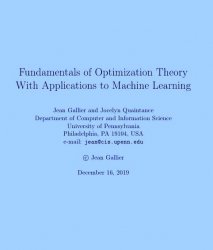 Название: Fundamentals of Optimization Theory With Applications to Machine Learning
Название: Fundamentals of Optimization Theory With Applications to Machine LearningАвтор: Jean Gallier, Jocelyn Quaintance
Издательство: Jean Gallier
Год: 2019
Формат: PDF
Страниц: 832
Размер: 13 Mb
Язык: English
In recent years, computer vision, robotics, machine learning, and data science have been some of the key areas that have contributed to major advances in technology. Anyone who looks at papers or books in the above areas will be baffled by a strange jargon involving exotic terms such as kernel PCA, ridge regression, lasso regression, support vector machines (SVM), Lagrange multipliers, KKT conditions, etc. Do support vector machines chase cattle to catch them with some kind of super lasso? No! But one will quickly discover that behind the jargon which always comes with a new field (perhaps to keep the outsiders out of the club), lies a lot of “classical” linear algebra and techniques from optimization theory. And there comes the main challenge: in order to understand and use tools from machine learning, computer vision, and so on, one needs to have a firm background in linear algebra and optimization theory. To be honest, some probability theory and statistics should also be included, but we already have enough to contend with.
Many books on machine learning struggle with the above problem. How can one understand what are the dual variables of a ridge regression problem if one doesn’t know about the Lagrangian duality framework? Similarly, how is it possible to discuss the dual formulation
of SVM without a firm understanding of the Lagrangian framework?
The easy way out is to sweep these difficulties under the rug. If one is just a consumer of the techniques we mentioned above, the cookbook recipe approach is probably adequate.
But this approach doesn’t work for someone who really wants to do serious research and make significant contributions. To do so, we believe that one must have a solid background in linear algebra and optimization theory.